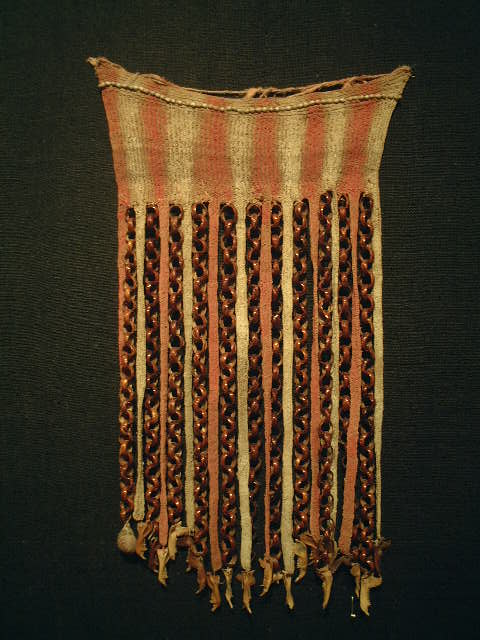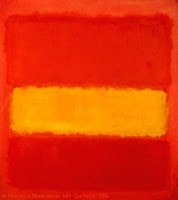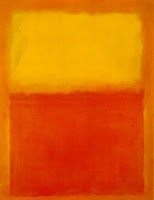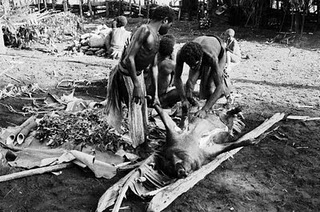|
|
|||||||||||||
 |
|||||||||||||
Many of the aprons from the highlands of Papua New Guinea express similar colour contrasts as those of the 20th cent abstract minimalist painter Mark Rothko.
|
Pig Killing ApronsThe Papua New Guinea Highlands is famous among anthropologists for the elaborate systems of ceremonial exchange through which “big-men” gain prestige, but is less conspicuous through museum collections of Oceanic art. This was because the most elaborate art forms were ephemeral, and were in particular connected with the spectacular decoration of the human body for dances associated with inter-clan exchange events, pig-killing ceremonies, and warfare. Dancers required a set of accoutrements including wigs, aprons, leaves, and feathers. Pearl shells, which were formerly very scarce, having been traded up from the coast, were mounted into resinous boards worn across the chest; large, solid wigs supported lorikeet, parrot, cockatoo, and cassowary feathers; fur, bones, grease, ferns, and croton leaves (ritually important across the Pacific) were added; while the most arresting feature was perhaps the heavy ochre face painting. Different paints and suites of decorations were appropriate to different occasions, and communicated appropriately: some were intended primarily to evoke the admiration of spectators, and to attract women; in other cases, colours bear meanings appropriate to particular cults, that preserved male well-being from the threat of female pollution. Associated religious beliefs were vital: decorations could not be worn without the approval of ancestors, but the person wearing the decorations was empowered by the evident proof of ancestral support. This typifies the way in which Oceanic art is often less about meaning or representation than about presence: decoration is not a symbol that stands for something else, but a manifestation of power and vitality. While Highlands art was, therefore, bound up with performance and context, various types of artefacts are nevertheless to be found in museum collections. Those most closely connected with the body arts are shields, painted in ways that echo painting on warriors’ cheeks; indeed, the shield as a whole was modelled on the body. The head or top was often decorated with feathers or tassels, and the circular motifs around the centre were identified with the navel. Highlands shields differ from those of the Sepik, the Asmat, and other low-lying and coastal New Guinea peoples in generally featuring solid fields of paint rather than a plethora of carved, low-relief motifs. "Oceanic Art," Microsoft® Encarta® Online Encyclopedia 2008 http://uk.encarta.msn.com © 1997-2008 Microsoft Corporation. All Rights Reserved.
The apron adorner is a pig-tail-fringed piece of knitting, varying in size and shape, from relatively small and triangular ... to large and rectangular, with long pig-tail-bedecked streamers. Regardless of size and shape the constant feature of adorners is the pigs' tails hanging along one side. Men wear them tucked into their bark girdles by two side straps, dangling sporran-like in front of their aprons. They put them on when donning their best 'yort onda' finery only, to enhance further their appearance for some grand event. These apron embellishers have never been popular with the Wola, in contrast to the Huli who commonly wear them as part of their daily dress. Until recently they were exceptionally rare, having passed out of fashion, but in the early 1980s there was a limited revival of interest in them, particularly in large streamered adorners knitted in bright red and yellow string ... They last for years, kept safely protected in leaf parcels, and worn at infrequent intervals ... ------------------------------------------------------------------
For the knitted piece a man requires string, which may be rolled from any suitable bast fibre ... the number of hanks required varies with the style of adorner: up to a dozen or more for a large streamered one ... Pigs' tails are in ready supply, even though they are somewhat in demand for ornamenting various other objects too. A man will collect them over a period of time, from animals he slaughters and those killed by relatives and friends ... The other materials required are, for colouring an apron adorner knitted in traditional dun string, ochre or powder paint, together with tigaso oil or pig grease ...
Although the knitted string parts of apron adorners vary in shape and size, the general pattern followed is constant, knitted in 'tesop' and 'minyaeb' stiches [in Wola] ... A man attaches a fringe of between one and two dozen pigs' tails to the knitted piece, either directly along the lower edge of the smaller ones or, if triangular-shaped, as they frequently are, along their two lower sides. On the larger versions he suspends them from the ends of the streamers that hang down from the pinafore piece. He removes the bone from the tails before tying them on, cutting them along one side and peeling it out, and pierces the skin near their base to dangle them from a piece of string ... some men thought that in the dim past apron adorners were more highly valued than today, which invites speculation about the tails and the origin of the adorner.
excerpt from Paul Silitoe, 'Made in Niugini: Technology in the Highlands of Papua New Guinea', British Museum Publications, London, 1988
Bibiliography
Scholarly/Book; Made in Niugini: Technology in the Highlands of Papua New Guinea; Paul Sillitoe; 1988, 454-456, For comparative apron adorner made by the Wola of Southern Highlands Province, see chapter 7, 'Finery and self-decoration'. |
|
|||||||||||
|
|
|||||||||||||
|
|
|||||||||||||
|
|
|||||||||||||
|
|
|||||||||||||
|
|
|||||||||||||
|
|
|||||||||||||
|
|
|||||||||||||
|
|
|
||||||||||||
|
Home| Photography| Oceanic Art | Links |Contact me Copyright © Your Company Name designed by Templatesbox |
|
||||||||||||
|
|
|
|
|
|
|
|
|
|
|
|
|
|
|



